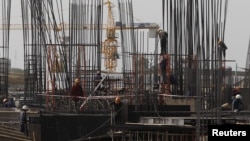The Asian Development Bank ( ADB) says the outlook for emerging Asian economies is upbeat into 2016 with economic growth in India and South East Asia offsetting a slowing Chinese economy. The ADB also sees risks ahead.
In its annual outlook released Tuesday, the Asian Development Bank is positive about Asia’s economies despite China’s growth slowing to a rate not seen in almost 25 years.
But China’s moderating economy will be offset by economic gains in India and South East Asia, a U.S. economic recovery and by low world oil prices, the bank said.
Speaking at a Hong Kong news briefing broadcast live on the internet, ADB Chief Economist Shang-Jin Wei said the outlook was generally upbeat over the next two years. “Developing Asia’s growth is holding steady [and] forecast to be 6.3 percent for this year and next year. That’s a consequence of India, Indonesia doing better than the recent past, offsetting the moderation in growth rates in the PRC [People’s Republic of China], Shang-Jin Wei stated. "Inflation pressure is lower due to a combination of domestic monetary policy reforms, such as in India, and lower commodity prices.”
In South East Asia, Thailand’s growth was also set to improve making a contribution to the region’s better economic prospects.
Several countries across the region, including India and Indonesia, had cut fuel subsidies in the lower fuel price climate, improving budget and fiscal outcomes and opening the way for more spending on social services.
But China’s economy, the region’s main driver, is forecast to slow to an annual growth rate of seven percent, due in part to cooling in investments, especially real estate. Wei said rising labor costs, demographic changes and a rise in the value of China’s currency, the Renminbi, also contributed to moderating growth.
In South East Asia, preparing for the official launch of the ten member ASEAN Economic Community (AEC), regional economies this year will see an uptick in growth in 2016 to more than five percent. The outlook for Pacific economies was also positive.
But in Central Asia, where growth had already slowed due to weak oil prices and the impact from the recession in Russia, economic growth will “slump further” the ADB said.
The ADB also warned of several risk factors, including policy “missteps” during China’s economic moderation, a slowing of India’s economic reforms, and uncertainties arising from the Greek debt crisis.
Another concern was the possibility any rise in U.S. interest rates would draw investment funds away from Asia and unsettle financial markets. The bank said a rebound in oil prices due to “geopolitical tensions” could undercut earlier gains from lower fuel costs.











